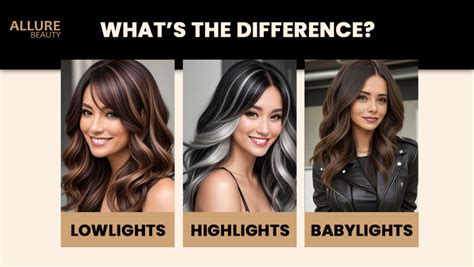Introduction

In the realm of hair artistry, highlights and balayage emerge as two transformative techniques that illuminate locks and elevate personal style. Both captivating options present distinct effects, offering endless possibilities for achieving a radiant and alluring mane. Dive into this comprehensive guide to unveil the intricacies of highlights versus balayage, empowering you to make an informed decision that aligns with your hair goals.
Section 1: Essential Distinctions
- Application Method:
- Highlights: Precise, individual strands are lightened using foil or a processing cap, creating a more defined and structured look.
- Balayage: Freehand painting technique where color is applied in soft, sweeping motions, resulting in a seamless and blended effect.
- Placement:
- Highlights: Typically applied in vertical sections from root to tip, following the natural hair growth pattern.
- Balayage: Subtly painted on the mid-lengths to ends, leaving roots natural for a subtle, sun-kissed appearance.
- Maintenance:
- Highlights: Require regular touch-ups every 4-6 weeks to maintain vibrancy and prevent fading.
- Balayage: Relatively low-maintenance, with touch-ups recommended every 12-18 weeks due to the blended nature of the technique.
Section 2: Defining Your Style
Highlights:
- Ideal for creating dramatic contrasts and enhancing texture.
- Suits straight or slightly wavy hair for a bold and structured effect.
- Can subtly enhance natural hair color or introduce a vibrant pop.
Balayage:
- Perfect for achieving natural-looking, sun-kissed dimensions.
- Suits all hair types, offering versatility for curly, wavy, or straight locks.
- Balances warmth and depth, adding warmth to cool tones and depth to warm tones.
Section 3: Pros and Cons
Highlights:
Pros:
– Precise control over placement and color intensity.
– Suitable for bold and dramatic transformations.
– Can correct uneven hair color or cover gray strands.
Cons:
– Requires more frequent touch-ups for upkeep.
– Can lead to damage if applied incorrectly or over-processed.
– May not be suitable for all hair types or textures.
Balayage:
Pros:
– Low-maintenance and less damaging than highlights.
– Creates seamless and natural-looking results.
– Suitable for a wide range of hair types and textures.
Cons:
– Less precise than highlights, may require multiple sessions to achieve desired effect.
– Can be more time-consuming than highlights.
– May not be suitable for all hair colors or desired levels of contrast.
Section 4: Common Mistakes to Avoid
- Over-processing: Too much lightener can damage hair, leading to breakage.
- Uneven application: Inconsistent streaks or patches can detract from the overall effect.
- Improper toner selection: Choosing the wrong toner can result in brassiness or unwanted undertones.
- Neglecting root touch-ups: Allow roots to grow out too long, creating a stark contrast and diminishing the intended effect.
- Applying color too close to the scalp: Can cause scalp irritation or damage.
Section 5: Frequently Asked Questions
- Which technique is better for dark hair? Balayage
- Which technique provides a more natural look? Balayage
- Which technique is less damaging to hair? Balayage
- Which technique is more expensive? Highlights
- Which technique is more time-consuming? Balayage
- What is the difference between partial and full highlights? Partial highlights only lighten a portion of the hair, while full highlights cover the entire head.
- What is the difference between ombre and balayage? Ombre creates a gradual transition from one color to another, while balayage focuses on natural-looking highlights.
- Can highlights and balayage be combined? Yes, for a dimensional and multi-toned effect.
Section 6: Innovative Applications
Bayalage for Men:
- Masculine and subtle highlights to add dimension and interest.
- Ideal for enhancing texture and creating a rugged appearance.
Root Stretch Balayage:
- Focuses on blending regrowth with subtle highlights.
- Creates a soft and natural transition from roots to ends.
Reverse Balayage:
- Darkens the mid-lengths to ends, creating a dramatic ombré effect.
- Ideal for transitioning from highlights to a more natural look.
Conclusion
Highlights and balayage offer distinct pathways to enhance hair color and elevate personal style. By understanding the key differences, pros and cons, and common mistakes to avoid, you can make an informed decision that aligns with your desired hair transformation. Whether you seek bold contrasts or subtle sun-kissed radiance, both highlights and balayage provide endless possibilities for creating captivating and unforgettable locks.
